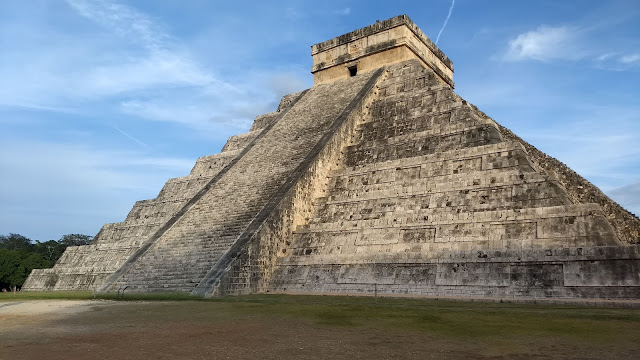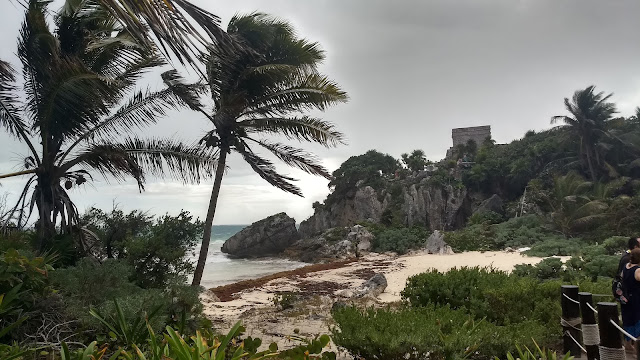The Maya city of Chichen Itza, famously one of the new Seven Wonders of the World, lies deep in the jungle of the Yucatan peninsula. Chichen Itza was a major city-state during the Maya Postclassic period, at the height of it's power from ~750-1050 CE. The ruins are sprawling, and offer plenty of evidence of everything the Mayan civilization is famous for: temples, human sacrifice, the Mesoamerican Ball Game where players (sometimes) get sacrificed, that calendar with the end of the world (kidding).
The Maya had an advanced writing system, but the Spanish destroyed almost all evidence of it except for temple wall carvings, which Chichen Itza has in abundance. Check out this ball player getting decapitated: those snakes represent BLOOD.
On our way to Chichen Itza, we stopped for lunch at a roadside strip of cafes. It's the only road to Chichen Itza, so it is definitely a tourist trap. As soon as we parked, dueling teams of menu-weilding restaurant hawkers descended on us. The restaurants were all functionally identical, so I made them seat half of our party at one restaurant, and the other half at the adjoining table in the neighboring restaurant. They were not amused by my solution, but I thought it was hilarious.
We also went to Tulum, a seaside Maya city complex dating from ~1000-1500 CE. Tulum was a major trading port, and the cliffside setting is gorgeous, but the exposure to wind and rain means the site's structures are smooth and eroded. We were lucky to visit during a brief storm and enjoyed the dark clouds and windy palm trees.
Mysterious ruins are everywhere- there's even one in the middle of Playa del Carmen's Quinta Avenue. Walk through one of the fish pedicure areas and next to a restaurant's kitchen storage area you'll find a tiny shrine surrounded with a wire fence and trash.
-PT
The Maya had an advanced writing system, but the Spanish destroyed almost all evidence of it except for temple wall carvings, which Chichen Itza has in abundance. Check out this ball player getting decapitated: those snakes represent BLOOD.
On our way to Chichen Itza, we stopped for lunch at a roadside strip of cafes. It's the only road to Chichen Itza, so it is definitely a tourist trap. As soon as we parked, dueling teams of menu-weilding restaurant hawkers descended on us. The restaurants were all functionally identical, so I made them seat half of our party at one restaurant, and the other half at the adjoining table in the neighboring restaurant. They were not amused by my solution, but I thought it was hilarious.
We also went to Tulum, a seaside Maya city complex dating from ~1000-1500 CE. Tulum was a major trading port, and the cliffside setting is gorgeous, but the exposure to wind and rain means the site's structures are smooth and eroded. We were lucky to visit during a brief storm and enjoyed the dark clouds and windy palm trees.
Mysterious ruins are everywhere- there's even one in the middle of Playa del Carmen's Quinta Avenue. Walk through one of the fish pedicure areas and next to a restaurant's kitchen storage area you'll find a tiny shrine surrounded with a wire fence and trash.
-PT


















